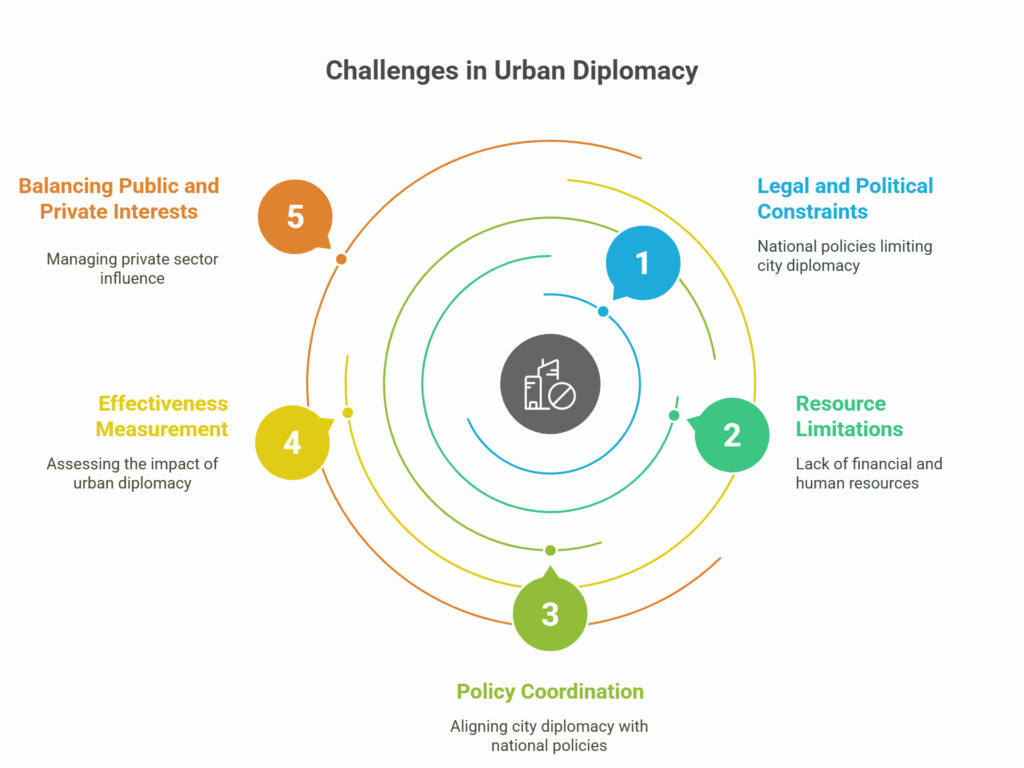Challenges in Implementing Urban Diplomacy
Urban diplomacy, as the international engagement of cities to achieve political, economic, and cultural goals, has gained increasing importance in recent years. However, its successful implementation faces multiple challenges that require careful analysis and strategic approaches. The following examines the key challenges, with a focus on existing evidence and global examples—particularly those relevant to developing countries and Iran.
Background and Significance of Urban Diplomacy
Urban diplomacy refers to the interactions between cities or between cities and international organizations. This can include bilateral agreements, cultural exchanges, and cooperation on issues such as climate change and migration. For instance, networks like C40 play a vital role in advancing global objectives. However, carrying out such activities demands resources, coordination, and legal support, which are often lacking.
Key Challenges in Implementing Urban Diplomacy
1. Legal and Political Constraints from National Governments:
-
National governments typically monopolize foreign policy, which can restrict cities’ diplomatic activities. For example, in Australia, the Foreign Relations Act (2020) allows the federal government to cancel international agreements made by cities, posing risks for urban diplomacy.
-
In the United States, the City and State Diplomacy Act represents an attempt to support subnational engagement, but such efforts still require alignment with federal policy.
-
In Iran, due to the high concentration of foreign policy power within the central government, cities may face more severe limitations in international interactions, especially in sensitive areas such as foreign relations.

2. Lack of Financial and Human Resources:
-
Cities, especially in developing countries, often struggle with budget constraints that make it difficult to implement diplomatic initiatives. A study on urban diplomacy in Tehran revealed that lack of resources is one of the major obstacles.
-
There is also a need for trained professionals in urban diplomacy. Research indicates that cities must build capacity and provide training for managers to effectively engage globally.

3. Need for Coordination with National and International Policies:
-
Aligning urban diplomatic activities with national strategies can be challenging. For instance, U.S. cities like New York and Los Angeles have attempted to uphold climate agreements such as the Paris Accord, even after the federal government’s withdrawal.
-
Such tensions can lead to policy inconsistencies, especially in areas like immigration and climate change.
4. Measuring Effectiveness and Impact:
-
Another challenge is assessing the effectiveness of urban diplomacy. Cities may struggle to measure the outcomes of their initiatives, which can influence financial and political support. Urban networks such as Urban20 require analytical tools to demonstrate their impact.
5. Balancing Public and Private Interests:
-
The growing role of the private sector in urban diplomacy can result in economic power being concentrated in a small number of cities. Studies show this may threaten transparency and representation.
-
In developing countries, this issue can be even more acute, as limited resources may drive cities to become overly dependent on foreign investment.

Challenges Specific to Developing Countries
In developing countries, additional challenges include political instability, infrastructure deficiencies, and difficulties in establishing international credibility.
Implementing urban diplomacy involves overcoming a range of challenges—from legal constraints and resource shortages to coordination demands and the need for impact evaluation. While these challenges may be more severe in developing countries, cities can still play a meaningful role in global governance through capacity-building and supportive legal frameworks.
